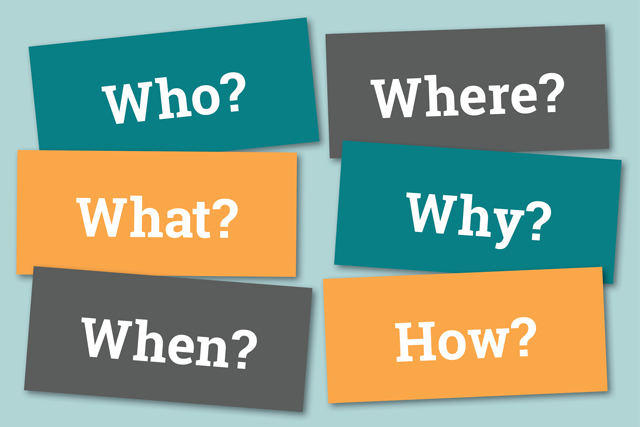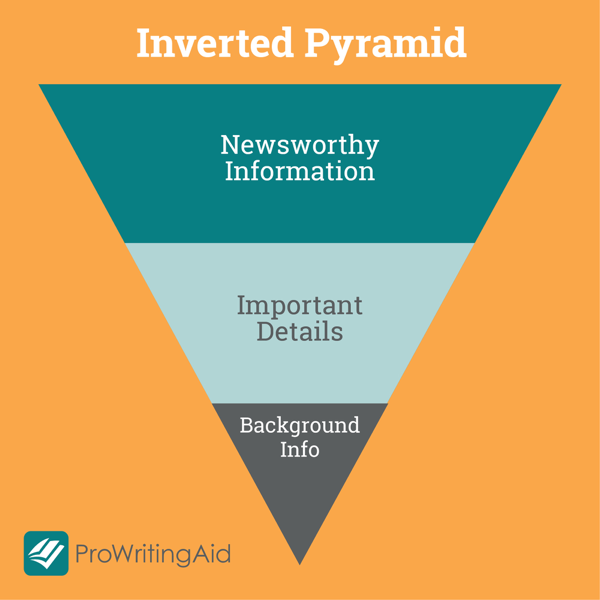
Storytelling is in vogue for articles. In stories, you build suspense by hinting at what will come next. But you can write compelling content by doing just the opposite with the inverted pyramid. Grab attention right away.
This article style delivers the goods up front. It delivers on a promise.
How Does It Work?
Big ideas come first. Readers don’t have to scroll down to get to the point.
Get into the details.
Add background.
Three steps to give readers what they want. The answer. The details. All the stuff they want to know. Rather than leading with a story that eventually gets to the point…
I was late to my weekly writing group, and it was my turn to bring refreshments. I drove the main roads which take longer to get to a grocery market. I wanted something tasty - everyone in the group has a sweet tooth - and a nonalcoholic beverage so we could focus on our writing shares. When I was in the baked good section in front of the bakery, I heard a loud voice. I turned around and saw three men in black clothing. One was pointing a gun at the cashier.
Boring. The story rambles to the point. By the time the reader gets to the important information, they’ve probably left.
The inverted pyramid starts with the main point.
On a quiet Tuesday evening, three men entered the grocery store and pointed a gun at the cashier.
The reader gets the point instantly. And, curiosity leads them to find the details.

The Beginning
The inverted pyramid gives readers the bulk of the information at the beginning. No tangential story to get readers empathizing. No teasers. Give readers the promise of the title.
First, write an enticing title that promises trustworthy information. The title encourages readers to want the information. Make it attractive and compelling.
Start with the most intriguing and compelling information. Immediately convey the basic information. Outline the basic information as quickly as possible in journalist style including the five ‘W’s and ‘How’.

Unlike a story that leads to the end, the salient information comes first in the inverted pyramid. Use salient points at the beginning to inform and engage. Satisfied readers keep going to find out more.
In our example, the reader knows:
- Who - three men
- What - pointed a gun at the cashier
- When - Tuesday evening
- Where - in the grocery store
- Why - (implied) to take money from the cash register
- How - using a firearm
The reader is ready for details that relate to the initial information.
Follow with Important Details
Once your reader knows your central point, give them the important details that back up your initial claim.
Using the robbery example, the reader may want to look for details that impact them personally. Was it close to where they live? Was this an unusual event or do robberies happen often at this grocery store? Was it a straightforward stick-up job or do the three men know the cashier?
Use the Inverted Pyramid for Each Paragraph
Use a standout, core sentence at the beginning of each paragraph. Paragraph by paragraph, use the inverted pyramid to give the important statement first, then follow up with details and background.
Focus On One Detail
Express only one point in each paragraph. Let the reader choose which points they want to read. With the first sentence as the main point, the reader can keep reading or go on to the next paragraph. One point per paragraph makes the article easy to follow.
Once you have gained the reader’s interest, give specifics that answer questions.
- “How did the robbers get in unnoticed?”
- “How did the cashier react?”
- “Did they get the money?”
- “What happened next?”
- “Were the robbers apprehended?”
Satisfy the reader with the details that sate the curiosity piqued by the headline and opening.
Follow with Context
Finally, tell the background story.
If our example is a fictional scene, this is where you dig in deep to the background of the gunman, the cashier, or both.
If it is a factual article, this is where you bring in data and statistics. You can talk about the rise of crime in the nation or the number of armed robberies compared with the number of suspects apprehended. You might present an argument for or against gun control.
Benefits of the Inverted Pyramid to Content
The inverted pyramid gives your writing power for three main reasons. Besides creating a strong article that is easy to follow, the inverted pyramid style enhances search engine optimization (SEO) and increases social media engagement.
Content Blocks
Because the inverted pyramid breaks text up into distinct, focused paragraphs, your article is easy for readers to scan and read. White space between paragraphs allows readers to find the information points.
Search engines scan content blocks for answers, which then appear in search results. Use structured data for your content blocks as signposts for each information chunk in your paragraph.
SEO Win
The inverted pyramid structure makes your information easily digestible for readers and search engines. Each section of text has the gist of the content at the beginning. For search engines this means your answer is right at the beginning of the paragraph section. This structure makes it easy for search engines to find the topic and supply your paragraph as an answer to a query.
Social Media
The same benefits that make the inverted pyramid article beneficial for SEO work just as well for social media. The structure of your article makes it easy to understand. Because it individualizes the topics for quick scanning, you increase the opportunity for shares of information that gets straight to the point.
People share emotional content. The best way to provoke emotion is to write a compelling title, an easy-to-share excerpt from the details, and thematic support with context. These are the essentials of the inverted pyramid.
History of the Inverted Pyramid
The inverted pyramid style emerged in the 19th century with the advent of sending articles by telegraph. For over a hundred years, journalists have used this writing technique, which has been adopted by advertisers to grab readers’ attention. It’s how those long-form direct mail pieces work.
Benefits for Writers
The inverted pyramid is a powerful tool for writers who want to connect with readers and boost search engine optimization (SEO).
Four Week MBA regales the inverted pyramid writing style as a masterful style for web articles.
Being one of the most effective methods of writing, this technique can help you write incredible SEO articles, drive more engagement, boost brand awareness and social shares.
If you’ve been looking for more engagement and notice on the web, try using the inverted pyramid to increase your visibility. If you’ve been struggling with the wave of “storytelling” article advice, try getting to the point. Your readers and search engines will take notice. You can’t go wrong with the sequence of hook, details, context.
Give your article extra punch with editing that improves readability. Try ProWritingAid to make your inverted pyramid story shine with every line.

